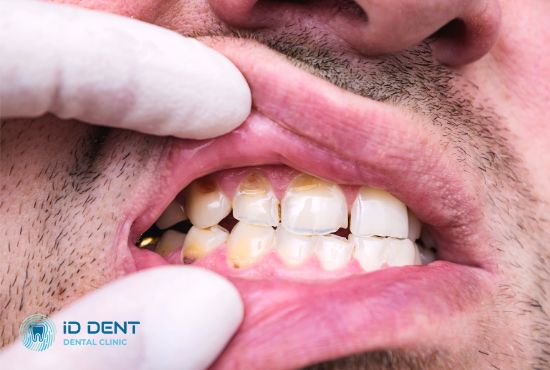Tooth Enamel Restoration
Tooth enamel restoration procedures improve external and internal factors. Don’t worry, it can be restored! Enamel restoration with special material ensures a beautiful smile, while the procedure is highly functional. Visit us at ID Dent clinic!
| Treatment period | depends on the method |
| Appearance quality | individual |
| Restoration methods | fluoridation, remineralization |
| Procedure characteristics | regular approach and care from the dentist |

Do your teeth react acutely to hot and cold, change color, or tend to decay? The problem lies in the enamel – the protective layer around the tooth. Under unfavorable factors – hard food, insufficient hygiene, trauma and damage – the enamel thins. Noticing such a problem, you should seek a dentist immediately. Dentists at ID Dent clinic in Kyiv will ensure quality enamel restoration. We will restore your teeth health and give your smile a Hollywood aesthetic!
Tooth enamel originates at the embryonic level. During this period, its primary and secondary mineralization occurs on a protein matrix. Enamel is a strong, hypermineralized tissue incapable of regeneration.
Main signs of tooth enamel destruction
Neglecting personal hygiene, harmful habits (smoking), poor diet, mechanical damage to teeth often lead to enamel destruction. This issue may arise at any age.

When the destruction is minor, you might feel completely normal. Later, symptoms like these appear:
- Sensitivity to hot, cold, sweet, or sour products.
- Color change in the enamel – yellowing or dark spots. Weak enamel makes teeth more prone to pigmentation from food, drinks, and tobacco.
- Changes in tooth appearance. The destruction of the protective layer can lead to hardens on the surface that appear as white spots. Continued destruction may cause cavities or defects needing treatment.
- A rough or uneven tooth surface sensation.
- Broken tooth edges. Weak and brittle enamel can make molars easily break or chip with small impacts.
Noticing even one of these symptoms, schedule a dentist appointment. A dentist will conduct a thorough diagnosis, help stop destruction at early stages, and prescribe proper treatment for you.
Main methods of tooth enamel treatment
A doctor selects the method of teeth restoration focusing on the individual clinical picture. The most commonly used are:
- Fluoride therapy. Fluoride-based medicines increase enamel’s resistance to acidic effects, stimulate natural remineralization (restoring minerals), and strengthen teeth.
- Remineralization. A special covering with remineralizing composition is made. You need to wear this at night for a period set by your dentist.
- Periodontal procedures. If enamel destruction results from periodontal disease, treatment may include methods aimed at infection control, root surface cleaning, and restoring soft tissue health.
- Veneers and crowns. In severe enamel damage or cavity formation, these may be used to restore the tooth’s shape, function, and aesthetic appearance. Veneers are thin overlays attached to the tooth’s front, while crowns cover the damaged tooth completely.
- Endodontic treatment. If enamel destruction reaches the tooth’s pulp, root canal treatment may be needed.
- Implantation. This method is used when the enamel damage surface is large and the tooth needs complete removal.

 Kyiv, st. Bratislavskaya 14B
Kyiv, st. Bratislavskaya 14B Mon.-Fri. 9-20, Sat.-Sun. 10-18
Mon.-Fri. 9-20, Sat.-Sun. 10-18







